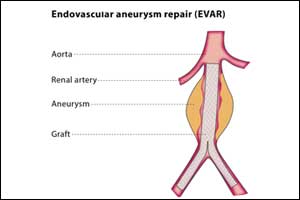- Home
- Editorial
- News
- Practice Guidelines
- Anesthesiology Guidelines
- Cancer Guidelines
- Cardiac Sciences Guidelines
- Critical Care Guidelines
- Dentistry Guidelines
- Dermatology Guidelines
- Diabetes and Endo Guidelines
- Diagnostics Guidelines
- ENT Guidelines
- Featured Practice Guidelines
- Gastroenterology Guidelines
- Geriatrics Guidelines
- Medicine Guidelines
- Nephrology Guidelines
- Neurosciences Guidelines
- Obs and Gynae Guidelines
- Ophthalmology Guidelines
- Orthopaedics Guidelines
- Paediatrics Guidelines
- Psychiatry Guidelines
- Pulmonology Guidelines
- Radiology Guidelines
- Surgery Guidelines
- Urology Guidelines
Endovascular aortic repair better than open repair for ruptured abdominal aortic aneurysms

Endovascular aortic repair (EVAR) surgery more beneficial for ruptured abdominal aortic aneurysms than open repair-NIHR Signals
EVAR surgery to repair a ruptured abdominal aortic aneurysm had a slightly better survival rate after three years than open repair surgery. The survival benefit in this trial wasn’t apparent 30 days after surgery, but those having EVAR did recover more quickly and went home sooner. This NIHR-funded study also found that EVAR is likely to be more cost-effective.
An abdominal aortic aneurysm is a swelling in the main artery that runs from the heart through the abdomen. If it bursts, there is catastrophic bleeding. The traditional treatment is urgent open surgery to repair the rupture. EVAR is a less invasive strategy using a tube of artificial material, placed inside the aorta from an incision in the groin under X-ray control, sealing the leak as well as reinforcing the wall of the vessel.
This study is the first to show that people may have longer-term benefits from a strategy using EVAR where technically suitable for burst aneurysms and open repair if not.
Why was this study needed?
Ruptured abdominal aortic aneurysms are a common vascular emergency in the older population, causing about 6,000 deaths each year in the UK. About 60% of people survive if they get surgery in time.
Previous research by Sweeting et al. hasn’t shown any clear differences in survival rate at 30 days. The aim of this study was to compare the clinical and cost-effectiveness after three years.
What did this study do?
The IMPROVE trial randomised 613 adults with clinically suspected ruptured aortic aneurysm to either an EVAR strategy group (316 participants), or an open repair group (297 participants). The EVAR strategy group had immediate CT scans followed by EVAR if anatomically possible, or open repair if not. The open repair group had traditional surgery, with optional CT scanning.
The trial took place in 29 vascular centres in the UK and one in Canada. It was primarily designed to measure mortality at 30 days, but follow-up was extended to three years.
Recruitment was difficult. Half of the potential participants did not enter the trial, mostly because they were unfit to have a CT scan or the intervention. Patient and clinician preference also limited participation; however, the pragmatic, real-world design for this trial improves the relevance of the findings to current UK practice.
What did it find?
- In the EVAR strategy group, 186/316 patients (62%) were anatomically suitable, but EVAR was not performed on 26 of them because of staffed endovascular suites not being immediately available. Overall, 154 patients in this group (49%) had EVAR. In the open repair group, 220/297 (74%) had the allocated procedure. EVAR was performed on 33 people in the open strategy group, mainly because the general anaesthetic was considered too risky for them.
- The mortality rate at 30 days was 35.4% in the EVAR strategy group and 37.4% in the open repair group (odds ratio [OR] 0.92, 95% confidence interval [CI] 0.66 to 1.28).
- At three years, mortality was 48% in the EVAR strategy group and 56% in the open repair group (OR 0.73, 95% CI 0.53 to 1.00).
- At three years, there was no difference in the quality of life between the groups.
- The average number of days in the hospital for aneurysm-related care (three years after randomisation) was 14.4 days for the EVAR strategy group and 20.5 days in the open repair group. This resulted in a total saving of -£2,607 (95% CI ‑£5,949 to £735) for the EVAR strategy.
What does current guidance say on this issue?
The NICE 2009 technology appraisal on EVAR for the treatment of abdominal aortic aneurysms only recommends the procedure if it is conducted as part of a trial.
NICE is currently developing a guideline on the diagnosis and management of abdominal aortic aneurysm, which is due to be published in November 2018 and will replace the 2009 technology appraisal. The draft guideline says that both EVAR and open repair can be considered for people with a ruptured abdominal aortic aneurysm and that EVAR may provide more benefit for women and men aged over 70.
What are the implications?
Three-year follow-up in the IMPROVE trial shows a survival benefit for the EVAR strategy over open repair. The EVAR strategy is also likely to be more cost-effective, with benefits for both patients and healthcare providers. There are, however, implications for staffing of endovascular services to provide 24-hour availability of EVAR.
An EVAR technique can only be carried out if the aorta and femoral arteries are a certain size and shape, and people with aortic aneurysms often have other health problems which can make EVAR difficult.
This study strengthens the evidence base for the use of EVAR to repair ruptured aneurysms in suitable people.
Citation
Ulug P, Hinchliffe RJ, Sweeting MJ, et al. Strategy of endovascular versus open repair for patients with clinical diagnosis of ruptured abdominal aortic aneurysm: the IMPROVE RCT. Health Technol Assess. 2018;22(31):1-122.
This article first appeared in NIHR Signals

Disclaimer: This site is primarily intended for healthcare professionals. Any content/information on this website does not replace the advice of medical and/or health professionals and should not be construed as medical/diagnostic advice/endorsement or prescription. Use of this site is subject to our terms of use, privacy policy, advertisement policy. © 2020 Minerva Medical Treatment Pvt Ltd